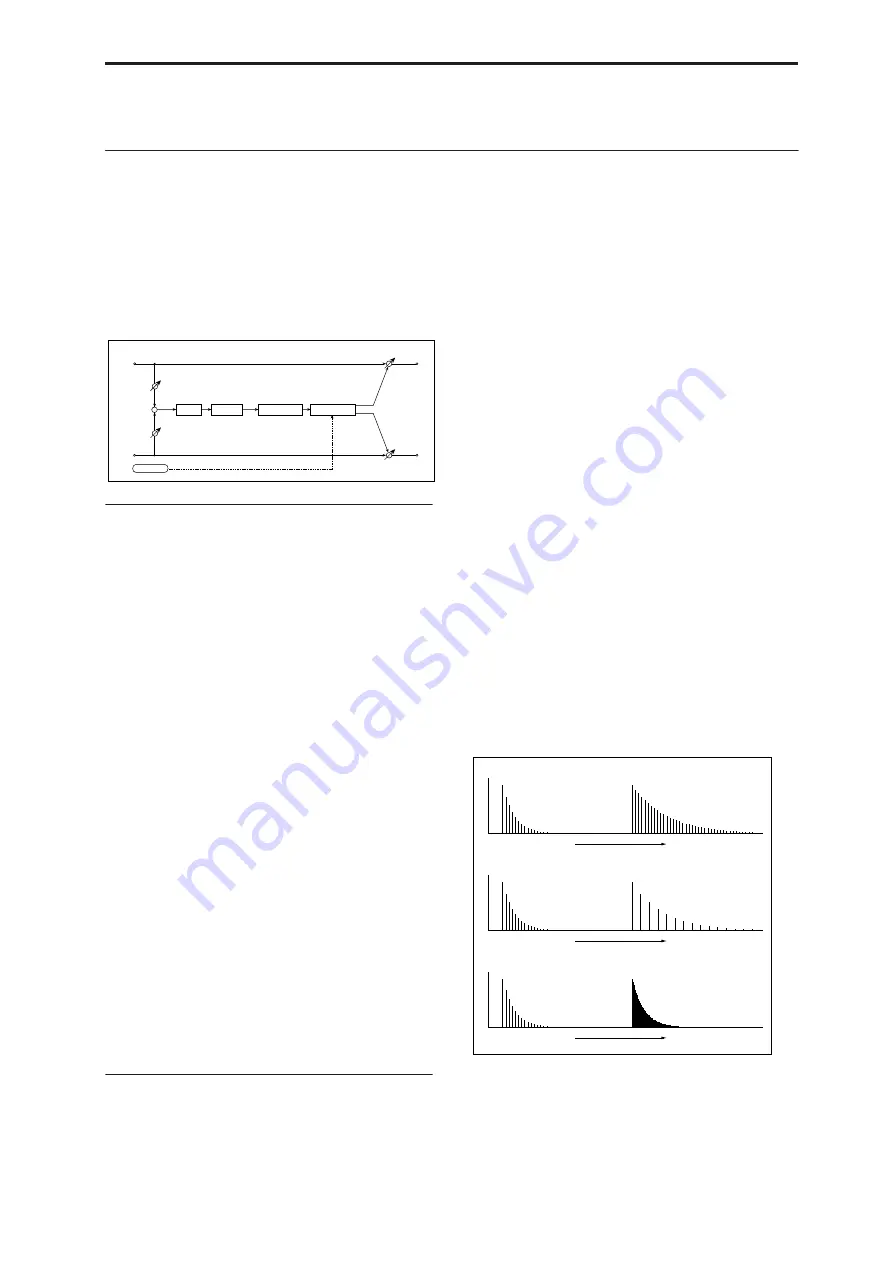
Reverb and Early Reflections 100: Overb
849
Reverb and Early Reflections
100: Overb
The O-Verb features a high-quality, diffusion-based
reverb core. In addition to setting the size of the room,
you can model its shape and materials by adjusting the
diffusion characteristics of both the initial reflections
and the main reverberant wash, and via separate
controls for the high, mid, and low decay times. The O-
Verb also includes randomization, for richer and
smoother reverb timbres.
Pre EQ
There are two fully parametric bands of peaking EQ,
for adjusting the reverb timbre. These affect only the
reverb, and not the dry signal. Both bands have
identical parameters.
Trim
[0…100]
Sets the EQ input level.
Band 1
Band1
[Check-box]
Switches the first band of EQ band on and off.
Fc [Hz]
[200…20.00k]
Sets the center frequency of Band 1.
Q
[0.5…10.0]
Sets the bandwidth of Band 1.
Gain [dB]
[–18.0…+18.0]
Sets the gain of Band 1.
Band 2
Band 2 has the same parameters as Band 1, above.
Rolloff
Rolloff
[0…100]
This controls a lowpass filter on the output of the
effect. Settings around 6-8kHz are good for producing
a warm, smooth sound.
REVERB
Pre Delay [msec]
[0…1360]
Sets the delay time from the dry sound.
Diffusion1
[0…100]
Diffusion 1
and
2
soften the sound before it enters the
reverb core, shaping the timbre of the initial reflections.
Setting both diffusers to around 50 generally produces
sufficient diffusion for smooth reverbs; extremely high
levels may cause ringing.
Some source material, such as vocals, may also benefit
from lower settings of diffusion, allowing for more
discrete echoes.
Diffusion1
and
Diffusion2
differ in how the
reflections are spaced, and the balance between these
two parameters will vary the character of the reverb.
Diffusion2
[0…100]
This is the second diffuser for the initial reflections. For
more information, see “Diffusion1,” above.
Size
[5…100]
Sets the size of the space.
Time
[0…100]
This sets the main reverberation time. The
Damping
and (bass)
Gain
parameters, below, let you adjust the
decay times separately for the high and low
frequencies, respectively.
Diffusion
[0…100]
This sets the density of reflections within the main
reverb. Low settings will produce more discrete
echoes, and high settings will produce a smoother
reverb. Extremely high settings may cause ringing.
Reverb Size, Time, and Diffusion
Damping
[0…100]
This sets the cutoff of the high-frequency damping
filter. If
Damping
is set to
100
, the high frequencies will
decay at the same rate as the low frequencies; at
0
, the
high frequencies will decay almost instantly.
Left
Right
Wet / Dry
Wet / Dry
Wet: Mono In - Stereo Out / Dry: Stereo In - Stereo Out
EQ Trim
+
EQ Trim
Pre Delay
Input Diffuser
Pre EQ
Reverb
LFO: Sine
Size: small
large
Diffusion: small
large
Size / Reverb Time / Diffusion
Reverb Time: small
large
Summary of Contents for Electronic Keyboard
Page 1: ...Parameter Guide Parameter Guide ...
Page 2: ......
Page 180: ...Program mode EXi 170 ...
Page 290: ...EXi STR 1 Plucked String 280 ...
Page 572: ...Sequencer mode 562 ...
Page 700: ...Global mode 690 ...
Page 751: ...Insert Effects IFX1 IFX12 Routing 741 Fig 2 3a Fig 2 3b ...
Page 902: ...Effect Guide 892 ...
















































